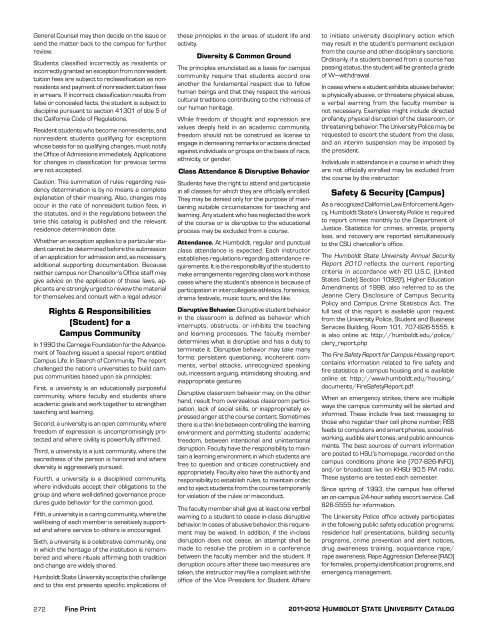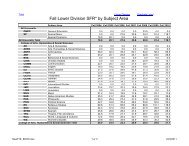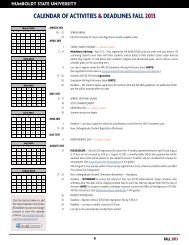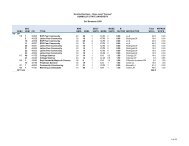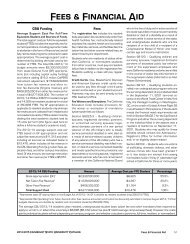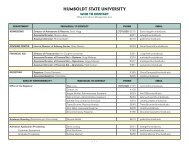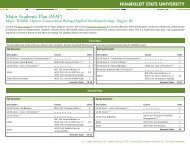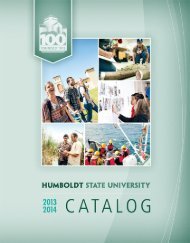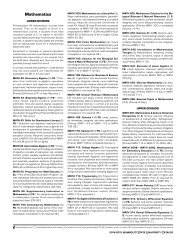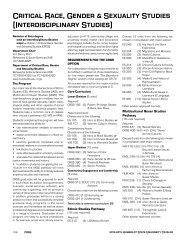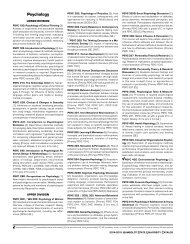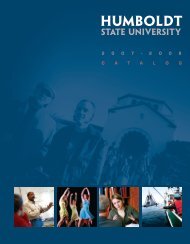2011-12 Academic Year - Bad Request - Humboldt State University
2011-12 Academic Year - Bad Request - Humboldt State University
2011-12 Academic Year - Bad Request - Humboldt State University
You also want an ePaper? Increase the reach of your titles
YUMPU automatically turns print PDFs into web optimized ePapers that Google loves.
General Counsel may then decide on the issue or<br />
send the matter back to the campus for further<br />
review.<br />
Students classified incorrectly as residents or<br />
incorrectly granted an exception from nonresident<br />
tuition fees are subject to reclassification as nonresidents<br />
and payment of nonresident tuition fees<br />
in arrears. If incorrect classification results from<br />
false or concealed facts, the student is subject to<br />
discipline pursuant to section 41301 of title 5 of<br />
the California Code of Regulations.<br />
Resident students who become nonresidents, and<br />
nonresident students qualifying for exceptions<br />
whose basis for so qualifying changes, must notify<br />
the Office of Admissions immediately. Applications<br />
for changes in classification for previous terms<br />
are not accepted.<br />
Caution: This summation of rules regarding residency<br />
determination is by no means a complete<br />
explanation of their meaning. Also, changes may<br />
occur in the rate of nonresident tuition fees, in<br />
the statutes, and in the regulations between the<br />
time this catalog is published and the relevant<br />
residence determination date.<br />
Whether an exception applies to a particular student<br />
cannot be determined before the submission<br />
of an application for admission and, as necessary,<br />
additional supporting documentation. Because<br />
neither campus nor Chancellor’s Office staff may<br />
give advice on the application of these laws, applicants<br />
are strongly urged to review the material<br />
for themselves and consult with a legal advisor.<br />
Rights & Responsibilities<br />
(Student) for a<br />
Campus Community<br />
In 1990 the Carnegie Foundation for the Advancement<br />
of Teaching issued a special report entitled<br />
Campus Life: In Search of Community. The report<br />
challenged the nation’s universities to build campus<br />
communities based upon six principles:<br />
First, a university is an educationally purposeful<br />
community, where faculty and students share<br />
academic goals and work together to strength en<br />
teaching and learning.<br />
Second, a university is an open community, where<br />
freedom of expression is uncompromisingly protected<br />
and where civility is powerfully affirmed.<br />
Third, a university is a just community, where the<br />
sacredness of the person is honored and where<br />
diversity is aggressively pursued.<br />
Fourth, a university is a disciplined community,<br />
where individuals accept their obligations to the<br />
group and where well-defined governance procedures<br />
guide behavior for the common good.<br />
Fifth, a university is a caring community, where the<br />
well-being of each member is sensitively supported<br />
and where service to others is encouraged.<br />
Sixth, a university is a celebrative community, one<br />
in which the heritage of the institution is remembered<br />
and where rituals affirming both tradition<br />
and change are widely shared.<br />
<strong>Humboldt</strong> <strong>State</strong> <strong>University</strong> accepts this challenge<br />
and to this end presents specific implications of<br />
these principles in the areas of student life and<br />
activity.<br />
Diversity & Common Ground<br />
The principles enunciated as a basis for campus<br />
community require that students accord one<br />
another the fundamental respect due to fellow<br />
human beings and that they respect the various<br />
cultural traditions contributing to the richness of<br />
our human heritage.<br />
While freedom of thought and expression are<br />
values deep ly held in an academic community,<br />
freedom should not be construed as license to<br />
engage in demeaning remarks or actions directed<br />
against individuals or groups on the basis of race,<br />
ethnicity, or gender.<br />
Class Attendance & Disruptive Behavior<br />
Students have the right to attend and participate<br />
in all classes for which they are officially enrolled.<br />
They may be denied only for the purpose of maintaining<br />
suitable circumstances for teaching and<br />
learning. Any student who has neglected the work<br />
of the course or is disruptive to the educational<br />
proc ess may be excluded from a course.<br />
Attendance. At <strong>Humboldt</strong>, regular and punctual<br />
class attendance is expected. Each instructor<br />
establishes regulations regarding attendance requirements.<br />
It is the responsibility of the student to<br />
make ar range ments regarding class work in those<br />
cases where the student’s absence is because of<br />
participation in intercollegiate athletics, forensics,<br />
drama festivals, music tours, and the like.<br />
Disruptive Behavior. Disruptive student behavior<br />
in the classroom is defined as behavior which<br />
interrupts, obstructs, or inhibits the teaching<br />
and learning processes. The faculty member<br />
determines what is disruptive and has a duty to<br />
terminate it. Disruptive behavior may take many<br />
forms: persistent questioning, incoherent comments,<br />
verbal attacks, unrecognized speaking<br />
out, incessant arguing, intimidating shouting, and<br />
inappropriate gestures.<br />
Disruptive classroom behavior may, on the other<br />
hand, result from overzealous classroom participation,<br />
lack of social skills, or inappropriately expressed<br />
anger at the course content. Sometimes<br />
there is a thin line between controlling the learning<br />
environment and permitting students’ academ ic<br />
freedom, between intentional and unintentional<br />
disruption. Faculty have the responsibility to maintain<br />
a learning environment in which students are<br />
free to question and criticize constructively and<br />
appropriately. Faculty also have the authority and<br />
responsibility to establish rules, to maintain order,<br />
and to eject students from the course temporarily<br />
for violation of the rules or misconduct.<br />
The faculty member shall give at least one verbal<br />
warning to a student to cease in-class disruptive<br />
behavior. In cases of abusive behavior, this requirement<br />
may be waived. In addition, if the in-class<br />
disruption does not cease, an attempt shall be<br />
made to resolve the problem in a conference<br />
between the faculty member and the student. If<br />
disruption occurs after these two measures are<br />
taken, the instructor may file a complaint with the<br />
office of the Vice President for Student Affairs<br />
to initiate university disciplinary action which<br />
may result in the student’s permanent exclusion<br />
from the course and other disciplinary sanc tions.<br />
Ordinari ly, if a student banned from a course has<br />
passing status, the student will be grant ed a grade<br />
of W—withdrawal.<br />
In cases where a student exhibits abusive behavior,<br />
is physically abusive, or threatens physical abuse,<br />
a verbal warning from the faculty member is<br />
not necessary. Exam ples might include directed<br />
profanity, physical disruption of the classroom, or<br />
threatening behavior. The <strong>University</strong> Police may be<br />
requested to escort the student from the class,<br />
and an interim suspension may be imposed by<br />
the president.<br />
Individuals in attendance in a course in which they<br />
are not officially enrolled may be excluded from<br />
the course by the instructor.<br />
Safety & Security (Campus)<br />
As a recognized California Law Enforcement Agency,<br />
<strong>Humboldt</strong> <strong>State</strong>’s <strong>University</strong> Police is required<br />
to report crimes monthly to the Department of<br />
Justice. Statistics for crimes, arrests, property<br />
loss, and recovery are reported simultaneously<br />
to the CSU chancellor’s office.<br />
The <strong>Humboldt</strong> <strong>State</strong> <strong>University</strong> Annual Security<br />
Report 2010 reflects the current reporting<br />
criteria in accordance with 20 U.S.C. (United<br />
<strong>State</strong>s Code) Section 1092(f), Higher Education<br />
Amendments of 1998, also referred to as the<br />
Jeanne Clery Disclosure of Campus Security<br />
Policy and Campus Crime Statistics Act. The<br />
full text of this report is available upon request<br />
from the <strong>University</strong> Police, Student and Business<br />
Services Building, Room 101, 707-826-5555. It<br />
is also online at: http://humboldt.edu/police/<br />
clery_report.php<br />
The Fire Safety Report for Campus Housing report<br />
contains information related to fire safety and<br />
fire statistics in campus housing and is available<br />
online at: http://www.humboldt.edu/housing/<br />
documents/FireSafetyReport.pdf<br />
When an emergency strikes, there are multiple<br />
ways the campus community will be alerted and<br />
informed. These include free text messaging to<br />
those who register their cell phone number, RSS<br />
feeds to computers and smart phones, social networking,<br />
audible alert tones, and public announcements.<br />
The best sources of current information<br />
are posted to HSU’s homepage, recorded on the<br />
campus conditions phone line (707-826-INFO),<br />
and/or broadcast live on KHSU 90.5 FM radio.<br />
These systems are tested each semester.<br />
Since spring of 1993, the campus has offered<br />
an on-campus 24-hour safety escort service. Call<br />
826-5555 for information.<br />
The <strong>University</strong> Police office actively participates<br />
in the following public safety education programs:<br />
residence hall presentations, building security<br />
programs, crime prevention and alert notices,<br />
drug awareness training, acquaintance rape/<br />
rape awareness, Rape Aggression Defense (RAD)<br />
for females, property identification programs, and<br />
emergency management.<br />
272 Fine Print<br />
<strong>2011</strong>-20<strong>12</strong> <strong>Humboldt</strong> <strong>State</strong> <strong>University</strong> Catalog


